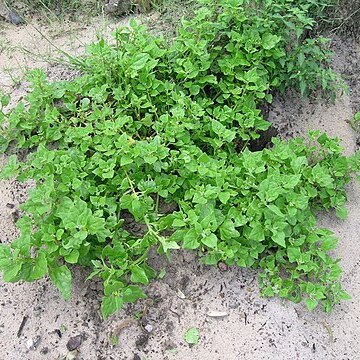Erect, ascending, prostrate or climbing herbs or undershrubs, studded all over with minute, shining, white papillae. Leaves spirally arranged, flat or slightly undu-late, fleshy, exstipulate. Flowers axillary, solitary or fascicled, sessile or stalked, greenish or yellowish. Perianth-tube produced above the ovary; segments 3-5, short, often unequal. Stamens 1 or more in the mouth of the perianth tube, alter-nating with the segments, solitary or in groups. Ovary semi-inferior, 2-9-celled, with 1 pendulous ovule in each cell. Styles equal in number to the cells, linear, stigmatose along the inner side. Fruit turbinate or obovoid with a hard, almost woody endocarp; the herbaceous or almost fleshy epicarp tipped with the enlarged calyx-limb, with apical tubercles or hornlets which not rarely develop into a flower, a branchlet or a spine, indehiscent.
Herbs to shrubs, annual to perennial, rarely dioecious or monoecious, with shiny white bladder cells and sometimes hairs. Stems erect, ascending, or prostrate. Leaves mostly alternate, flat, folded, or with margin rolled downward, fleshy, entire or slightly undulate, not stipulate. Inflorescences of solitary flowers or cymes often resembling fascicles. Flowers bisexual or unisexual, sessile or pedicellate, perigone lobes (3 or)4(-7), inside yellow or green, basally united into a short tube, nut base often angled. Stamens 4 or more, fused basally with perigone tube. Ovary inferior, 2-8-loculed, each locule with one pendulous ovule. Stigmas as many as locules. Fruit a nut, perigone persistent, base turbinate or obovoid, angled or winged, mostly with 4 rows of ornaments, often apically as horns. Seeds subreniform or pear-shaped.
Often minutely papillose annual or perennial herbs or subshrubs. Leaves alternate, entire, subsucculent. Stipules absent. Flowers axillary, solitary or fasciculate, sessile or pedunculate, hermaphrodite or unisexual, greenish or yellowish. Calyx gamosepalous, the tube produced above the ovary, 3–5-lobed. Stamens few to many, alternate with the calyx-lobes, solitary or fasciculate. Ovary semi-inferior or inferior, 1–9-locular; ovules 1 perloculus, pendulous; styles as many as the loculi, linear, free. Fruit simple, dry, hard, indehiscent, terete, winged, ridged, horned or spiny. There is much to be said for treating this and the following genus as members of a separate family, the Tetragoniaceae, more closely allied to the Nyctaginaceae and Gyrostemonaceae; see Friedrich in Phyton 6: 220–263 (1956).
Sprawling or climbing herbs or shrublets, usually papillose. Leaves alternate, flat, entire, somewhat succulent. Flowers in axillary clusters of 1–5, sessile or pedicellate; bracts absent. Perianth segments 4 or 5, coloured inside. Stamens 4 to many, alternating with perianth lobes or scattered; staminodes 0. Ovary inferior; styles 2–10, free; locules as many as styles; ovules 1 per locule; placentation apical. Fruit indehiscent, dry or succulent, with hard endocarp, ridged, winged or horned, sometimes papillose. Seeds 1 or several, pear-shaped, light-brown.
Fls with calyx tube adnate to ovary, often produced, 3-5-lobed; petals 0; stamens 1-many. Ovary 2-8-celled; styles as many as cells. Fr. globose to turbinate, endocarp hard, mesocarp fleshy or not. Herbs or subshrubs with trailing to erect stems; lvs alt., ± succulent. About 25 spp. mostly of S. Africa.
Ovary semi-inferior or inferior, (l)2–8(9)-locular, with 1 pendulous ovule per loculus and as many styles as the loculi, linear and free.
Flowers axillary, solitary or fasciculate, subsessile or pedunculate, greenish or yellowish.
Stamens 3–?, alternate with the perianth-segments, solitary or fasciculate.
Perianth-segments united, the tube produced above the ovary, 3–5-lobed.
Annual or perennial herbs or subshrubs, often minutely papillose.
Fruit hard, winged, horned or spiny.
Leaves subsucculent.

